Global
Copyright@ Australian Catholic University 1998-2025 | ABN 15 050 192 660 CRICOS registered provider: 00004G | PRV12008
Copyright@ Australian Catholic University 1998-2025 | ABN 15 050 192 660 CRICOS registered provider: 00004G | PRV12008
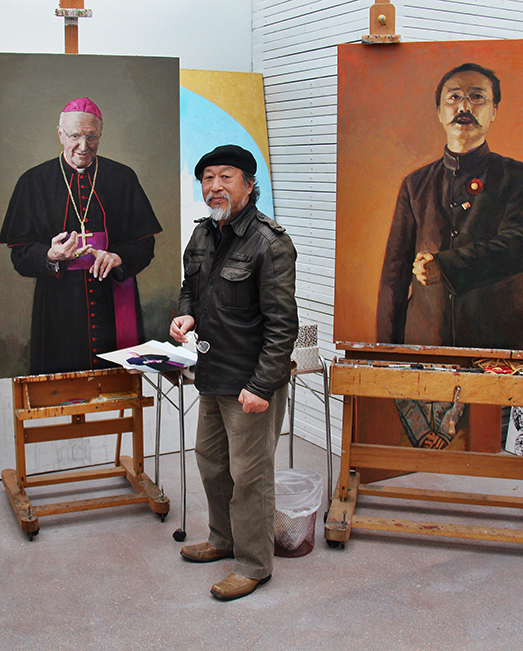
The former Red Guard revolutionary who became a portraitist to fame and royalty.
Shen Jiawei ambles down the pathway outside his multi-storey house in Bundeena, the picturesque beachside suburb that’s home to a diverse range of artists and creative types. Dressed in a dapper chocolate-brown jacket and his signature beret, he’d look more at home in the Parisian cafes of the 1920s than this sleepy hamlet on the edge of Sydney’s Royal National Park. But Jiawei, a Sulman Prize-winning painter and regular Archibald finalist, is as much a part of this community as any of his neighbours.
“We are very lucky,” he says later, while admiring the expansive ocean and bushland views from his living room. “It’s a peaceful place, a beautiful place.”
He’s right: the views are impressive. And so is this contemporary home, Jiawei’s second in Bundeena since he and his artist wife Lan Wang moved to the suburb in 1997. But there’s another part of the house he’s much more keen to show off.
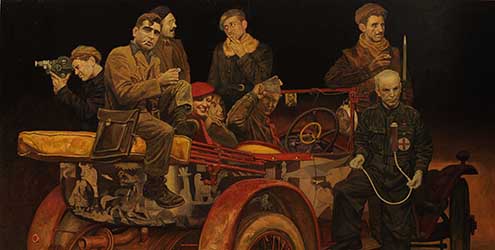
Spain 1937 (2012)
He leads the way to his brand-spanking-new studio, a cavernous space with high ceilings and vast walls, adorned with the beginnings of a series of mural-sized paintings that are reminiscent of his masterpiece, The Third World (2002): an epic work that features 92 ‘third-world’ heroes and villains like Mother Teresa, Saddam Hussein and the corpse of Che Guevara, grouped together as if posing for a family photo.
He walks straight past one of his most striking surrealist works, Spain 1937 (2012) — a bizarre scene featuring a jeep-load of artists and intellectuals who took part in the Spanish Civil War — and heads towards the far end of the studio, where portraits at various stages of completion stand on easels.
They include an almost-finished painting of Reverend Denis Hart, the former Archbishop of Melbourne — one of five works ACU has commissioned Jiawei to produce during a close working relationship spanning several years. He has also painted the University’s former chancellor, the now-retired governor-general Sir Peter Cosgrove, and its long-serving Vice-Chancellor, Professor Greg Craven.
Portraiture is Jiawei’s bread-and-butter, providing him with an income and an opportunity to rub shoulders with politicians, popes and a princess, but he also loves to produce works depicting history — a practice that stems from his beginnings as an artist during the Cultural Revolution.
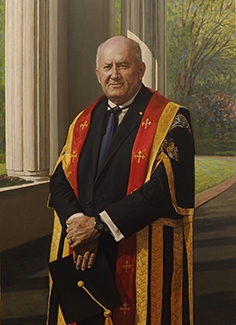
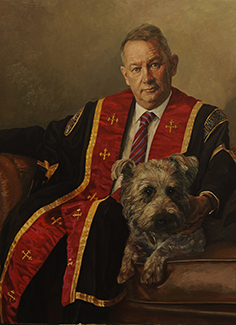
Sir Peter Cosgrove (2014) and Professor Greg Craven with dog Darcy (2015)
“I’m a student of history,” Jiawei says, “and it’s been my main artistic goal for a long time now to make paintings that show the big things: politics, society, the world and the great men and women of history.”
As a student in 1960s China, Jiawei became a team leader of the revolutionary Red Guards, who were fanatically loyal to Chairman Mao Zedong.
However, as a free thinker, he was acutely aware of the contradictions in the Maoist doctrine. Jiawei had read Edgar Snow’s classic account of the birth of Chinese communism, a book that was banned in China at the time, and which coloured his views of the regime and later inspired his first large-scale history painting, Red Star Over China (1987).
When Jiawei graduated from high school in 1966, his hopes of studying art were dashed when Mao closed all universities. He served in the army and eventually left his hometown near Shanghai to work as a farmhand in Manchuria, where he honed his craft by painting portraits of his peasant comrades.
Jiawei rose to prominence when one of his oil paintings, Standing Guard for Our Great Motherland (1974), caught the eye of Mao’s wife, Jiang Qing, who ordered that it be printed in newspapers and on posters to be displayed all over China.
“It was even reproduced on a 10-metre high tower that faced the Soviet Union,” says National Portrait Gallery historian, Sarah Engledow. “If you can imagine that, it's like a giant billboard of Chinese soldiers saying 'We're watching you!’”
There was one problem with the painting: it was a little too realistic for Madame Mao’s liking.
In late 1974, Jiawei travelled to Beijing to see Standing Guard at the National Art Museum. He recalls having mixed feelings on spotting it in the exhibition hall.
“At first, I was happy because it was displayed in the most prominent position in the room,” he says. “Then, when I got closer, I was in for a shock … I could see that the two soldiers’ faces had been given exaggerated, fierce expressions.”
As was common at the time, Madame Mao had had the painting “fixed” to suit the propagandist style the regime preferred.
Meanwhile, an internal struggle was brewing between Shen Jiawei, the revolutionary, and Shen Jiawei, the realist painter — who was becoming one of China’s best-known artists.
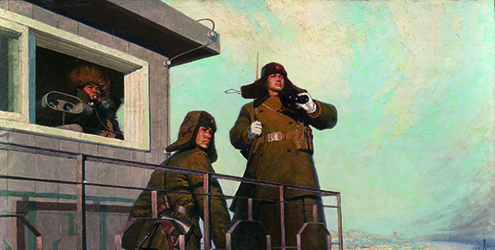
Standing Guard for Our Great Motherland (1974)
“I saw myself as a revolutionary, but I was still an artist,” he recalls. “This is something that I am very proud of: that even during the madness of the Cultural Revolution, I wanted my paintings to be real.”
After Mao’s downfall, Standing Guard was unceremoniously dumped in a gallery basement, but Jiawei managed to rescue the painting, and years later, it was restored and exhibited at the Guggenheim in New York and Bilbao.
The original was bought in Beijing in 2009 for around $1 million and is now displayed at the Long Museum in Shanghai — but Jiawei’s personal replica has pride of place near the entrance of his studio.
“I like to have this here because this painting has become a cultural artefact in Chinese history,” he says. “It has an amazing story of survival, and it reminds me of the good times, but also of the bad.”
Attached to Jiawei’s studio is his personal office and library, with a curved floor-to-ceiling bookshelf containing thousands of books — most in Chinese language, but many also in English.
Alongside hundreds of weighty tomes on socialist history are biographies of the people he’s painted, like the former Australian prime minister, John Howard, and the high-profile barrister, Tom Hughes QC.
“Reading is my first love,” Jiawei says, as he moves towards the bookshelf. “I love it even more than painting.”
He pulls out two novels, Aleksandr Solzhenitsyn’s The Red Wheel and Boris Pasternak’s Dr Zhivago — both set during the Russian Revolution. It’s clear by both the subjects he chooses to paint, and the books he chooses to read, that Jiawei has an enduring fascination with socialist history.
But he’s never once been tempted to resettle in his communist homeland.
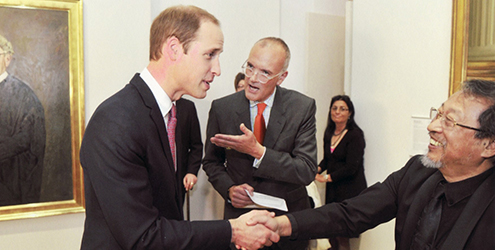
Jiawei meets Prince William.
“When I visit China, I see the worst parts of communism and the worst parts of capitalism," Jiawei says.
By comparison, he sees Australia as political paradise.
“I love this country, and at a deep level, I love this system,” he adds, as a smile forms on his face. “Sometimes I joke that this is the real socialist country.”
Jiawei was among the tens of thousands of Chinese students granted asylum in Australia in the late-1980s. He arrived just months before the Tiananmen Square massacre, but his wife was still in China and gave birth to their daughter Sidney as civilian casualties were rushed to the hospital.
“I didn’t realise how bad it had become,” he says. “It felt like China was going back in time, but in some ways it was even worse, because they used the army to kill their own people. That didn’t even happen in Chairman Mao’s time.”
Jiawei was attending language school in central Sydney every morning, and from midday until late at night, he made a living sketching tourist portraits at Darling Harbour: $5 -10 for a cartoon, $20 for a black and white sketch, $30 for a colour portrait.
But this was no fall from grace for a painter who was famous in his homeland; rather, he viewed it as an opportunity to improve his skills.
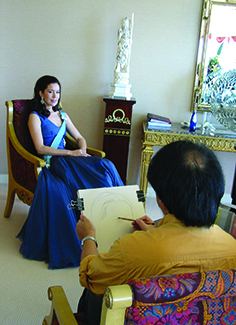
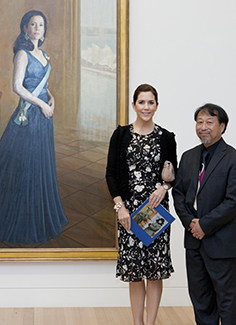
Jiawei with Princess Mary
“Yes, I worked very hard, and I sat on the street painting people, but still I was painting, so I was happy,” he says.
“I saw these years as an opportunity to become a professional portraitist. It was not lost time at all, it was a very important step in my growth as a painter.”
After half a dozen years scratching out a living in Australia, Jiawei gained recognition once again when he won the Mary MacKillop Art Award in 1995. He received a medal from Pope John Paul II at a ceremony in the Powerhouse Museum, just a stone’s throw from his Darling Harbour stomping ground.
The award set off a string of high-profile commissions, and today Jiawei’s creative works sell for tens of thousands of dollars. He has won several art prizes, been chosen as a finalist of the Archibald on 14 occasions, and has painted official portraits for many prominent public figures, including Pope Francis and Denmark’s Crown Princess Mary — a blessing he never takes for granted.
“A portraitist who has the opportunity to paint important people in history is very fortunate, and I'm very grateful for that opportunity,” Jiawei says, adding that he still sees himself as “an ordinary person who, by chance, has met many very famous people”.
But alas, in the art world, fame and commercial success does not guarantee critical acclaim, and some have labelled Jiawei’s painting style as overly realistic or academic.
That criticism is perhaps best answered by the respected Australian art writer John McDonald, who labels Jiawei as “one of the most misunderstood painters at work in this country” and is a big fan of his art. Jiawei’s critics, McDonald wrote in 2010, ignore “the many surreal touches in his work that could never be viewed as pure realism”.
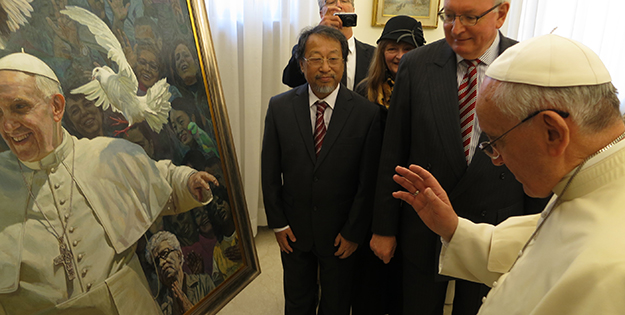
As it happens, Jiawei doesn’t seem too fussed about the criticism. He’s happy to just keep painting.
In the coming months, he hopes to turn his attention to the unfinished mural-sized paintings that hang on his studio’s main walls.
When complete, the larger of the works will feature some 400 figures spread over 90 canvas panels that cover more than 100 square metres of wall space. The paintings will eventually form one work titled Tower of Babel, which could take up to five years to finish — an ambitious undertaking.
“Sometimes I get lazy,” says Jiawei, although, given his prolific output, he’s surely being facetious.
“Nowadays I am 71, and I am still very busy, so I will have to work very hard to finish these works. As they say, time is precious.”
Copyright@ Australian Catholic University 1998-2025 | ABN 15 050 192 660 CRICOS registered provider: 00004G | PRV12008